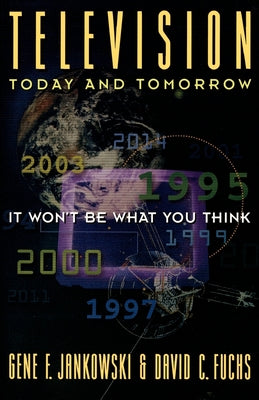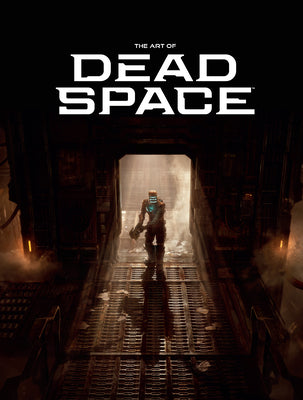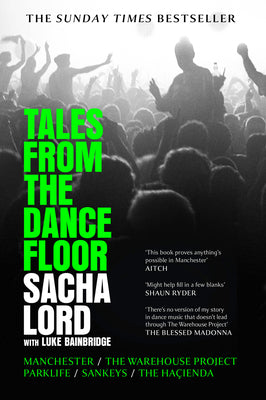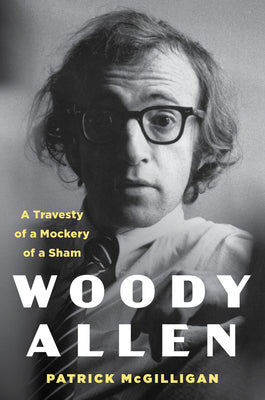
all Products
Performing Arts
Television
Television Today and Tomorrow: It Won't Be What You Think
Television Today and Tomorrow: It Won't Be What You Think
Jankowski, Gene F.
Select Format
Regular price
$39.77 USD
Regular price
$41.87 USD
Sale price
$39.77 USD
Unit price
per
Shipping calculated at checkout.

In recent years, the media has been awash in exuberant tales of the arrival of the information superhighway, when television will explode with exciting possibilities, offering some 500 channels as well as a marriage of TV and computer that will provide, on command, access to the latest movies, magazines, newspapers, books, sports events, stock exchange figures, your bank account, and much, much more. And the major TV networks, pundits add, will be doomed to extinction by this revolution in cable, computers, and fiber optics. But in Television Today and Tomorrow, Gene Jankowski--former President and Chairman of the CBS Broadcast Group--and David Fuchs--also a former top executive at CBS--tell a different story. They predict a bumpy road ahead for the information superhighway, and the major networks, they say, are abundantly healthy and will remain so well into the next century.
The information superhighway, Jankowski and Fuchs admit, will dramatically increase the distribution channels, but it will have little impact on the amount of programming created--and this may spell disaster. The authors show how the networks began as a way to provide programs to local stations (who could not afford to produce their own), who in turn provided the distribution that gave networks access to mass audiences and ultimately large advertising dollars. They then offer us an inside look at television production--showing us, for instance, a veteran scriptwriter putting together a breakfast table scene for "Cloud Nine"--to underscore how much effort goes into producing just two minutes of primetime programming. They reveal that the present 20 channels require some 20,000 hours of programming each year, which is more than all the Broadway plays produced in this century, and they conclude that without a dramatic increase in programming (which won't happen if only because of the very finite supply of talent), the superhighway will be jammed bumper-to-bumper with reruns, old movies, and inexpensive programming aimed at tightly focused audiences ("narrowcasting" as opposed to "broadcasting"). This is hardly the bonanza the pundits have promised. The authors point out that the media blitz about the new technology has hardly focused on programming, or on funding, or on what needs these 500 channels will fill. The major networks, on the other hand, will remain the only means of reaching the whole country, and the only channels that offer a full schedule of current, live, and original programs, free of charge. And thus they will continue to attract most of the audience of TV viewers. The real loser in the cable revolution, the authors contend, is PBS, whose role as an alternative to network TV has been usurped by cable stations such as The Discovery Channel and Nickelodeon.
This is a brass tacks look at television with an eye on the bottom line by two men who boast over sixty years of experience in the medium. If you want to understand television in America, where it came from and where it is going, you will need to read this book.
The information superhighway, Jankowski and Fuchs admit, will dramatically increase the distribution channels, but it will have little impact on the amount of programming created--and this may spell disaster. The authors show how the networks began as a way to provide programs to local stations (who could not afford to produce their own), who in turn provided the distribution that gave networks access to mass audiences and ultimately large advertising dollars. They then offer us an inside look at television production--showing us, for instance, a veteran scriptwriter putting together a breakfast table scene for "Cloud Nine"--to underscore how much effort goes into producing just two minutes of primetime programming. They reveal that the present 20 channels require some 20,000 hours of programming each year, which is more than all the Broadway plays produced in this century, and they conclude that without a dramatic increase in programming (which won't happen if only because of the very finite supply of talent), the superhighway will be jammed bumper-to-bumper with reruns, old movies, and inexpensive programming aimed at tightly focused audiences ("narrowcasting" as opposed to "broadcasting"). This is hardly the bonanza the pundits have promised. The authors point out that the media blitz about the new technology has hardly focused on programming, or on funding, or on what needs these 500 channels will fill. The major networks, on the other hand, will remain the only means of reaching the whole country, and the only channels that offer a full schedule of current, live, and original programs, free of charge. And thus they will continue to attract most of the audience of TV viewers. The real loser in the cable revolution, the authors contend, is PBS, whose role as an alternative to network TV has been usurped by cable stations such as The Discovery Channel and Nickelodeon.
This is a brass tacks look at television with an eye on the bottom line by two men who boast over sixty years of experience in the medium. If you want to understand television in America, where it came from and where it is going, you will need to read this book.
Accessories:
No Accessory
Publisher
OXFORD UNIV PR
Bisac Major Subject
Performing Arts
Bisac Minor Subject
Television - General
Binding Type
Paperback
Edition Description
Revised
Country Of Origin
US
Number Of Units
1
Length
8.03 Inches
Barcode Indicator
ISBN
Width
5.35 Inches
Publication Date
1996-11-01
Height
0.53 Inches
ISBN 10
019511129X
Weight
0.47 Pounds
Book EAN
9780195111293
Target Audiance
Adults
User reviews will be displayed here...
Related products or products you might find interesting

20% OFF
The Bible Recap: Deepen Your Understanding of God's Attributes from Every Book in the Old Testament
Cobble, Tara
$17.21 USD Shop Now
Art & Art Instruction

Art & Art Instruction

20% OFF

Architecture
Window Shopping with Helen Keller: Architecture and Disability in Modern Culture
Serlin, David
$121.96 USD Shop Now
Art & Art Instruction

Biography / Autobiography

Biography / Autobiography

Biography / Autobiography
Tales from the Dancefloor: Manchester / The Warehouse Project / Parklife / Sankeys / The Ha
Lord, Sacha
$30.00 USD Shop Now
Biography / Autobiography



